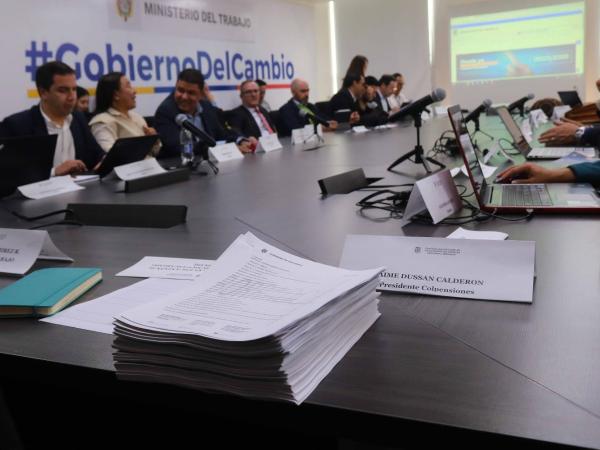Given the uncertainty that had been generated around the pension reform project, which will be filed on March 22, the labor and wage policy negotiation table delivered the bases of the project and released the draft of the articles.
(Labor reform: the modifications that would be made to the project).
The body, made up of trade unions, unions and the Ministry of Labor, is meeting starting this Monday to agree on the final text. The 50-page draft is made up of 89 articles and the main change that the Gustavo Petro administration is proposing to the current system is to replace it with a unified model of pillars.
The project would seek that in a first pillar, solidarity, 2.5 million adults over 65 who today do not have old age protection are sheltered and would receive a monthly income of $223,000, which would increase according to the growth of the country.
This pillar seeks to shelter people in conditions of extreme poverty, poverty and vulnerability. Initially, the Government’s proposal was to provide a subsidy equivalent to half the minimum wage.
(These are the changes that the pension reform would have).
The project also proposes a semi-contributory pillar to provide an income to those people over 65 years of age who have not been able to retire, but who have weeks of contributions either in Colpensiones or in a Pension Fund Administrator (AFP). According to the draft of the project, this would be financed with the general budget of the Nation.
A third pillar is the contributory one, which has two components, the Average Premium, managed by Colpensiones, and the Individual Savings, in charge of the AFPs.
The first is made up of all the people affiliated with the system and will receive contributions for income between 1 and 3 current legal monthly minimum wages (smlmv). The second component is integrated, according to the draft, “for all people affiliated with the system whose income is greater than three smlmv and will receive contributions for the part of the contribution base income that exceeds three smlmv and up to 25 smlmv”.
(Lifetime pensions for former presidents: why Latin countries pay them).
With this change, of the 18.3 million affiliates that the AFPs have, around 90% would go to Colpensiones. This would also put an end to the subsidies for high pensions that Colpensiones manages today.
“At the labor agreement table we have the clear intention of working on the pension reform project that we will present to the Congress of the Republic”, highlighted the Minister of Labor, Gloria Inés Ramírez, who announced that, for the sake of further discussion, this will be filed on February 22 and not tomorrow, as originally sought.
Another novelty is the creation of a savings fund, contemplated in article 24 of the draft, as a special account managed by Colpensiones through autonomous patrimonies, financial entities or trusts. It will be made up of a percentage of the income from pension contributions received by Colpensiones. The fund will have an investment regime “admissible in the market”, such as the acquisition of TES.
Another point is the ministry’s proposal, which consists of compensating women who have dedicated part of their lives to care work with 50 weeks of contributions for each child.
(What to do if you exceed the minimum weeks to retire).
The draft also indicates that the acquired rights of pensioners will be respected, and that there are no changes in disability or survivor pensions.
In addition, article 76 defines a transition regime so that all people affiliated with the system who have contributed 1,000 weeks will respect the conditions established in the previous regime (Law 100 of 1993). AND Article 77 opens a two-year transfer opportunity for those in that rank.
The labor reform will be filed this Thursday
The negotiation table for labor and salary policies has also advanced these days in the final text of the labor reform, which will reach Congress this Thursday. The draft that was presented in the consultation space, and that is being discussed to this day, consists of 30 pages and 72 articles.
In the main points of the draft, the figure of reinforced stability is maintained, the change in the daytime shift, which proposes the payment of night hours from 6:00 pm, the formalization of workers through applications and some union rights.
LAURA LUCIA BECERRA ELEJALDE








